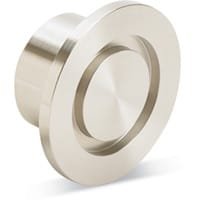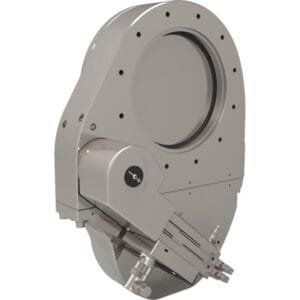KF (QF) HV Blank Stubs (Brass): Reliable Port Sealing for General High-Vacuum Applications
KF (QF) HV Blank Stubs (Brass) are practical, cost-effective components used to permanently or temporarily seal unused KF ports in high-vacuum (HV) systems. Designed in accordance with ISO-standard KF (Klein Flansche) geometry, these blank stubs integrate seamlessly with existing KF flange hardware and are ideal for laboratory, OEM, and light industrial vacuum applications operating down to 10⁻⁸ Torr.
Constructed from high-quality brass, KF (QF) HV Blank Stubs (Brass) are well-suited for general-purpose vacuum environments where extreme corrosion resistance and high-temperature durability are not essential. Brass offers good machinability, thermal conductivity, and ease of handling, making these stubs ideal for use in modular or reconfigurable systems where port capping or future expansion is expected.
Each KF (QF) HV Blank Stub (Brass) features a KF flange at one end and a closed-off stub or tube section on the other. This design allows the component to function as a solid end-cap while still maintaining compatibility with standard KF elastomeric o-ring sealing systems. The o-ring, housed in a centering ring, is compressed between chamfered flange faces using a KF clamp—which may be a wing-nut, thumbscrew, bolt-style, or over-center lever variant. This results in a dependable, leak-tight seal for vacuum pressures from atmosphere down to ultra-high vacuum levels.
Because of their brass construction, KF (QF) HV Blank Stubs (Brass) are not recommended for corrosive or reactive gas environments but excel in applications where lightweight, non-magnetic, and low-cost components are desirable. They are especially useful in educational laboratories, general R&D setups, small-scale vacuum coating systems, or prototype vacuum assemblies.
These blank stubs also serve as effective temporary seals during maintenance, system bakeouts, or phased equipment installation. They can be removed and reused repeatedly thanks to their robust flange construction and compatibility with reusable KF clamps and centering rings.
TFM offers KF (QF) HV Blank Stubs (Brass) in standard KF flange sizes, including KF16, KF25, KF40, and KF50, to suit common vacuum system dimensions. All components are machined to meet precise tolerances and ensure proper mating with other ISO-KF hardware. Custom variants, such as extended stubs or vented versions, are available upon request.
In summary, KF (QF) HV Blank Stubs (Brass) provide a dependable and economical method for sealing KF ports in high-vacuum systems. Their compatibility, ease of use, and material affordability make them an essential utility component in vacuum system construction, maintenance, and testing.
Ordering Table
Accessories Table
| Description | For | Per Package | Part Number |
| Cast Clamps (Aluminum) | KF10, KF16 Flanges | 1 | QF16-075-C |
| Cast Clamps (Aluminum) | KF25 Flanges | 1 | QF25-100-C |
| Cast Clamps (Aluminum) | KF40 Flanges | 1 | QF40-150-C |
| Cast Clamps (Aluminum) | KF50 Flanges | 1 | QF50-200-C |
| Lever Clamps (Aluminum) | KF10, KF16 Flanges | 1 | QF16-075-CHA |
| Lever Clamps (Aluminum) | KF25 Flanges | 1 | QF25-100-CHA |
| Lever Clamps (Aluminum) | KF40 Flanges | 1 | QF40-150-CHA |





Reviews
There are no reviews yet.